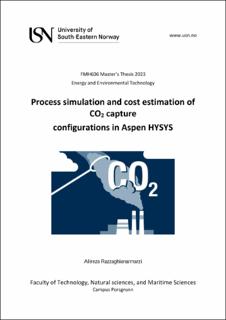| dc.description.abstract | The use of amine-based carbon capture technology to capture CO2 is a renowned technique. To evaluate and potentially utilize CO2 capture techniques, economic assessments are very necessary and the performance of equipment in different configurations can potentially have a significant impact on capital and operating expenditures.
In this project, it is aimed to investigate the impact of varying flashing pressures on the cost of steam consumption and electricity in a vapor recompression system. By analyzing these parameters, the study aims to optimize the operating expenditure (OPEX) and the capital expenditure (CAPEX) associated to the system, contributing to the advancement of cost-effective process designs.
In this study, a base case was created in Aspen HYSYS V12 comprising a desorber packing height of 6 m and an absorber packing height of 10 m. The minimum temperature approach (ΔTmin) for the lean/rich amine heat exchanger was maintained at 10 °C. The vapour recompression case was simulated for comparisons, in which the inlet gas flow was 85000 [kmol/h] with a lean MEA rate of 120000 [kmol/h]. The estimation of the equipment units' dimensions was done based on the simulation results. The EDF method was utilised in conjunction with Aspen In-Plant Cost Estimator V12 to calculate the total, operational, and capital costs for the two scenarios. In order to assess the economic viability of vapour recompression and examine its effects, the sensitivity analysis for this project sets the flash separator pressure at 80–120 kPa. The aim is to determine how this pressure range affects CAPEX, OPEX, and the cost of capturing CO2. Then, it is compared two cost estimation methods (the EDF and Nazir-Amini) together.
The EDF technique was used to determine the TPCs (CAPEX) for the base case and vapour recompression scenario, resulting in values of 64.34 M€ and 118.68 M€ in 2021. The projected yearly operational expenditure (OPEX) for the base case is around 32.14 M€/yr, but for the vapour recompression scenario at 100 kPa, it amounts to 28.9 M€/yr.
As part of the sensitivity analysis for the vapour recompression, the pressure in the flash separator was varied in order to determine how this variation affected the total cost. The optimal performance of the flash separator was determined to be 120 kPa. In this pressure, OPEX and CAPEX are determined at 28.3 M€/yr and 98.8 M€ respectively.
The base case, the vapour recompression (100 kPa), and the vapour recompression (120 kPa) scenario were projected to have CO2 capture costs of 37.34 €/ton CO2, 33.34 €/ton CO2, and 31.42 €/ton CO2, respectively. According to the investigation, the cost of carbon capture can be decreased by raising the flash pressure in the vapour recompression. Therefore, the results illustrate that the most economical scenario is the vapour recompression case at optimal pressure of 120 kPa. | |
